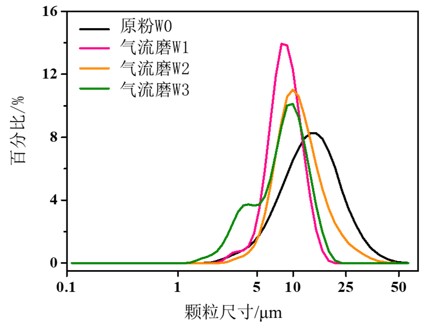
采用对喷式气流磨装置对商业钨粉(费氏粒度为5 μm,纯度>99.9%)进行处理。以氮气为研磨介质,设定研磨腔压力为0.7 MPa,在分选轮的频率为10~50 Hz的范围内对原料钨粉进行改性处理。然后对不同分选轮频率处理而得的钨粉进行粒度搭配,以获得不同粒度分布的粉末,设置了四种批次粉末进行对照实验。分别对四种批次钨粉进行冷等静压-中频感应烧结,四种批次钨粉的压制烧结实验全程在相同条件下完成。利用BT-9300ST激光粒度仪测试粉末的粒度分布及比表面积;利用Rigaku-D/MAX-RB旋转阳极 X射线衍射仪(X-ray diffraction,XRD)测定粉末的物相;采用阿基米德排水法测定烧结态样品的密度,为避免残余孔隙影响,测量前将样品表面涂抹凡士林;利用WDW-50万能试验机对烧结态样品进行室温三点抗弯测试,测试样品尺寸为3×3×21 mm,跨距设置为10 mm,测试前样品表面被机械抛光至光亮。
A counter-jet jet mill is used to process commercial tungsten powder (the Fisher particle size is 5 μm, and the purity is >99.9%). Nitrogen is used as the grinding medium, the pressure in the grinding chamber is set to 0.7 MPa, and the raw tungsten powder is modified within the frequency of the sorting wheel within the range of 10-50 Hz. Then, the tungsten powders processed by different sorting wheel frequencies were matched in particle size to obtain powders with different particle size distributions. Four batches of powder were set up for comparison experiments. Four batches of tungsten powder were subjected to cold isostatic pressing-medium frequency induction sintering, and the entire process of pressing and sintering the four batches of tungsten powder was completed under the same conditions. Use the BT-9300ST laser particle size analyzer to test the particle size distribution and specific surface area of the powder; use the Rigaku-D/MAX-RB rotating anode X-ray diffraction (XRD) to determine the phase of the powder; use Archimedes drainage Method to determine the density of sintered samples, in order to avoid the influence of residual pores, apply petroleum jelly on the surface of the samples before measurement; use the WDW-50 universal testing machine to perform room temperature three-point bending test on the sintered samples. The size of the test sample is 3×3×21. mm, the span is set to 10 mm, and the surface of the sample is mechanically polished to be bright before the test.